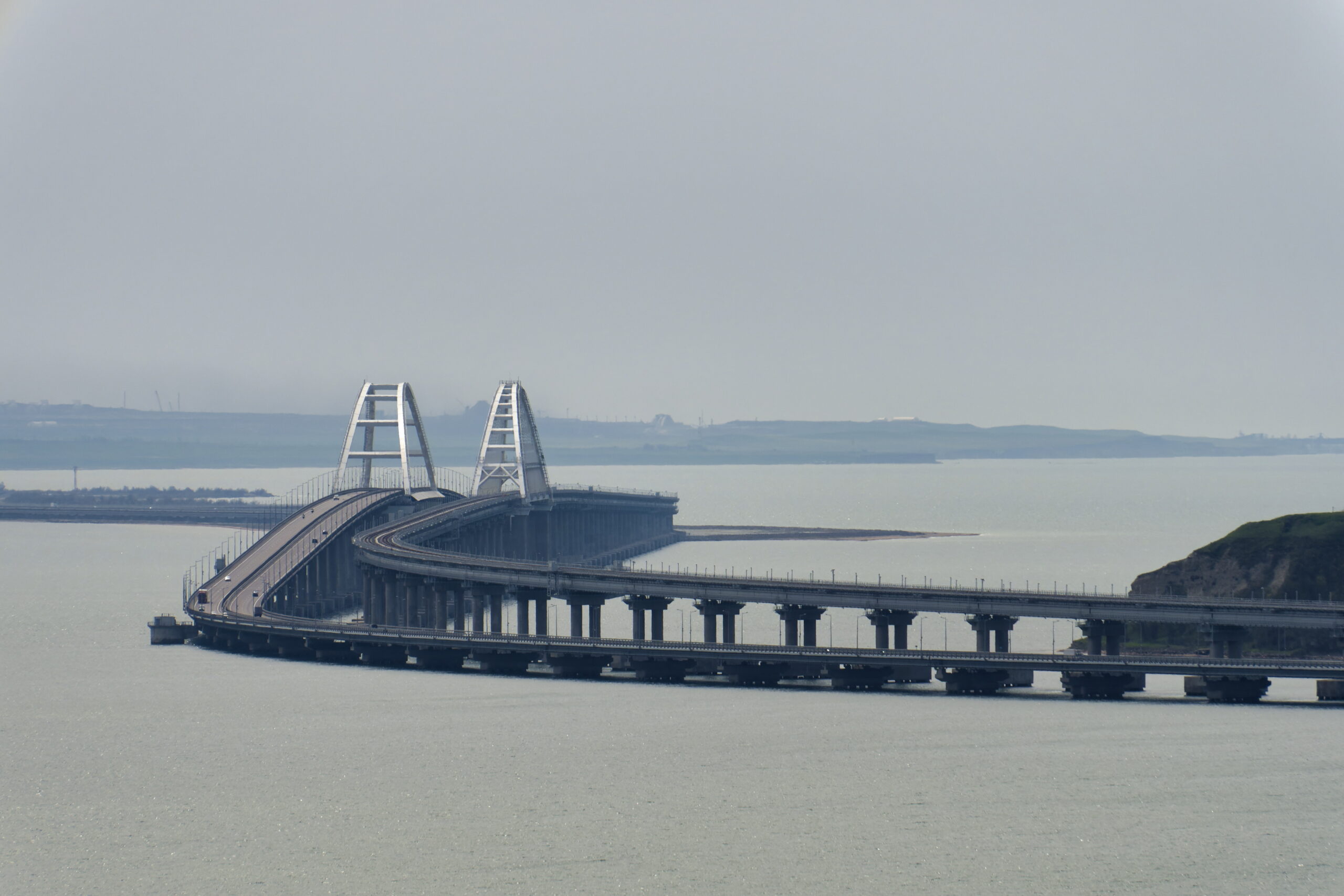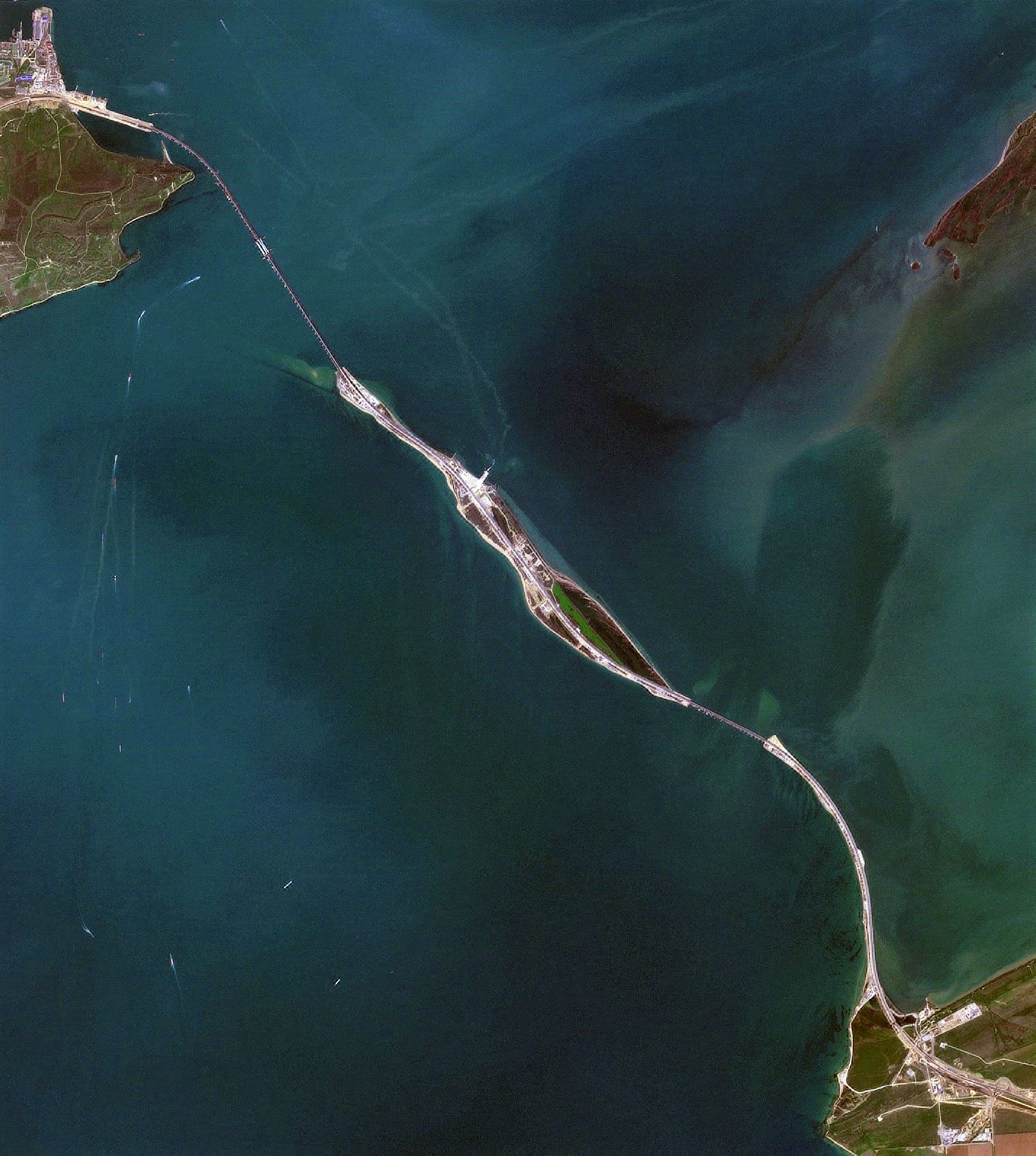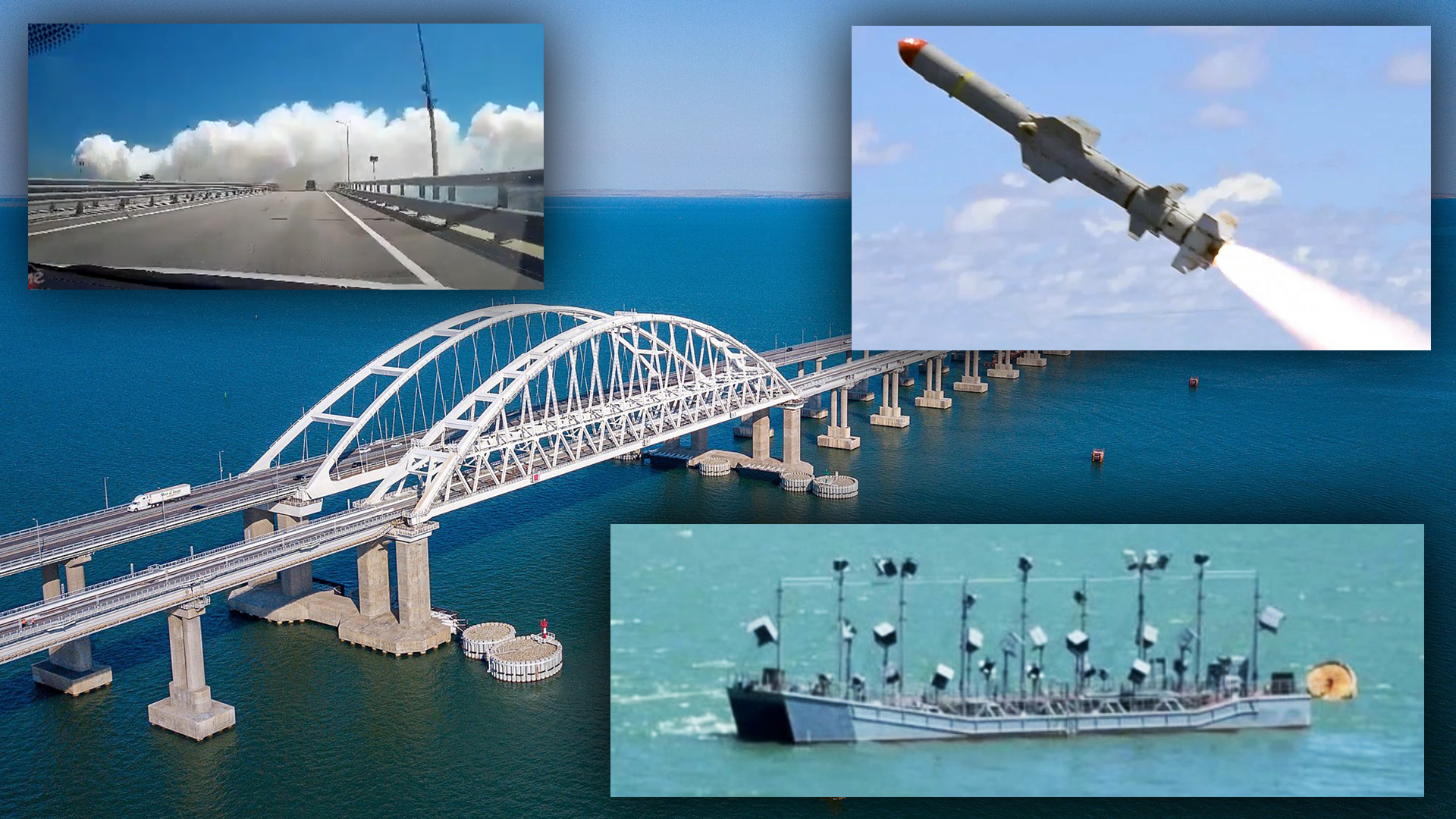Russia has deployed a number of countermeasures to the Kerch Strait Bridge connecting Russia and Crimea, including decoy barges covered in radar reflectors as well as smokescreen capabilities that were used in test exercises over the weekend.
The bridge, which was built between 2016 and 2018 and includes both automotive and rail lanes, is incredibly important to Russia. Its connection between mainland Russia and Crimea, which it seized from Ukraine in 2014, is both symbolic and strategic. The recent developments appear to be preparations to protect the bridge from a standoff missile attack, and while countermeasures are evidently being deployed and tested, it is unclear if they will be withdrawn or remain a static fixture going forward.
Independent defense analyst H I Sutton, or @CovertShores on Twitter, reported on the findings Monday, July 4, detailing that two target barges coming from Novorossiysk Naval Base had been towed to the location and moored on the east side of the bridge. He went on to note that the vessels were covered with multiple radar reflectors, which are metallic devices that are affixed to a barge in order to make it more visible to radar. Sutton used the term ‘target barges’ to identify the ships because the Russian Navy is known to have utilized such vessels as targets during exercises with the Black Sea Fleet. Now, it appears their intended purpose could be to act as decoys, confusing incoming missiles aimed at Kerch Bridge. Other radar reflectors were also seen affixed to the shallows near the bridge. It isn’t clear if these were part of the countermeasures or navigational features.
On July 1, a smokescreen test was also carried out by Russian forces, with footage of the exercise having been captured by locals attempting to cross the bridge while the aerosol was being dispersed. Smokescreens are a relatively standard defense tactic historically used to shield military movements, and the specific type of aerosol used could challenge the imaging functions of technologies like imaging infrared seekers used on precision-guided munitions and especially more advanced cruise missiles that use scene/object matching to autonomously attack their targets. Multi-spectral cameras found on surveillance craft like the RQ-4 Global Hawk and other drones could also be impacted. They can also obscure some imaging satellites. Russia is notorious for using smokescreens as a major tactic and has troops partially dedicated to employing them. In the recent past, strategic targets have been obscured during exercises and operations, like in November 2021 when the Russian Navy used them to shroud its naval base at the Syrian port of Tartus.
During the recent test, however, the smoke quickly enveloped a portion of the bridge, which led to auto accidents caused by poor visibility. Sutton explained that the dense white smoke had quickly dissipated by the time satellites passed above, both preventing the opportunity for an aerial view and further supporting the assumption that the event was likely just an exercise or a test of systems now in place.

“These measures are unusual and suggest improvisation,” wrote Sutton over email. “There is no ‘standard’ defense, but in wartime, people try their best to reduce the risks… The target barges are not designed for this. They are for training your own forces on hitting ships. If Ukraine tried to use anti-ship missiles, like Harpoon, to hit the bridge they might be effective. But it is not a standard procedure.”
Both of these recent efforts, on top of the knowledge gained in May that Russia was increasing its air defense capabilities in Crimea — which are already known to be very dense — appear to be focused, at least in part, on protecting the Kerch Bridge. This could indicate that the Russian military is, at the very least, worried about a potential attack. Other components would very likely include electronic warfare systems that help detect and confuse enemy missiles.
The 11-mile-long stretch of Russian-built infrastructure is one of the longest bridges in Europe and acts as a road for Crimean and Russian citizens to traverse, the primary general supply route into the peninsula, as well as a means of transport for Russian military equipment. It also acts as something of a strategic choke point. This allows Russia to more easily keep its “fingers on the throat of Azov,” as described by the Ukrainian Think Tanks Liaison Office in Brussels. Via the strait and the bridge that crosses over it, Russia could control all shipping into Ukraine’s ports on the Sea of Azov, all of which it now occupies. In fact, Russia used it as an economic weapon prior to the invasion in just such a manner. Basically, everything that the Kerch Bridge signifies would make it an incredibly juicy target for Ukrainian forces — that is if they have the will and firepower to carry out such an attack.
The Kerch Bridge itself isn’t close to Ukrainian-controlled territory anymore by any means, which raises questions about the specific kind of attack that Russia fears Ukraine — or someone else — could carry out. Because of the distance, Sutton suggested an aerial attack may be in consideration but went on to cite that the presence of Russian S-300 and S-400 missile systems would certainly impede such efforts. An undersea attack could be possible in theory but is highly unlikely on nearly every level.

Launching a missile attack against the structure would absolutely require the long-range weapons systems that the Ukrainian government has insisted on being in need of. To answer the call, both the United States and Denmark have donated a number of RGM-84 Harpoon anti-ship missiles and shore-based launchers to Ukrainian forces. The RGM-84 missile uses active radar homing to detect and track targets and boasts a range of up to 67 miles under optimal circumstances, but there is no point in Ukrainian territory not held by Russia anywhere near that distance to the bridge.
Advanced Harpoon variants and those modified to carry a smaller warhead and more fuel are able to make nearly triple that range, but it is not clear if Ukraine has this capability. If they do not, it’s not clear how Ukraine would employ its only foreign standoff missile, or even its locally-designed Neptune counterpart, against the bridge unless a clandestine operation was executed, where the Harpoon was launched at sea within range or from a concealed vehicle within Russian territory.
There is also the question of if the Harpoon could reliably strike the bridge. It is an anti-ship missile, not one designed for land-attack in littoral situations. The SLAM and SLAM-ER, cousins of the Harpoon with infrared seekers, were designed for that. Still, it may be possible that Harpoon’s active radar seeker could be used to engage the bridge in a crude land-attack manner, thus why towing a decoy barge with a huge radar cross-section into position near the bridge may make some sense, with the idea that the Harpoon will attack the more luminous and ship-like target, but the smoke would have no impact on the missile’s seeker. Infrared seeker-equipped missiles could be impacted by it, though.

Not only that, but the missile itself would need to be equipped with a warhead powerful enough to weaken the tons upon tons of fortified concrete and steel the Kerch Bridge is made up of. Still, any strike, even a minor disabling one, would be symbolic. The use of a High Mobility Artillery Rocket System’s (HIMARS) guided rockets is even more limited in terms of range than Harpoon, although they would be able to more easily and reliably strike the bridge in key areas, including weak spots. But there is no Ukrainian territory within over four times HIMARS range to employ the system against the target.
Now that these systems are in action, though, Russia may still be worried about their employment against the bridge in some capacity, even if the chance of it happening would be remote. Ukrainian Major General Dmytro Marchenko made an announcement in June that Kerch Bridge should be the country’s “number one target,” calling it an “umbilical cord” that allows for the transfer of military reinforcements to Russia. Marchenko went on to assert that Ukrainian forces should outright “cut it off” being that the bridge acts as a route through which reserve forces are brought to Russia and that Russia would panic if it did so.

Ukraine’s actions against Russia’s occupation of Snake Island, which led to Russia eventually fleeing the western Black Sea outpost, are also top-of-mind among Russian commanders. While the circumstances are very different with Kerch Strait Bridge, having it come under attack of any type would be a very embarrassing event for Russia and a major win for Kyiv.
It’s also possible that these precautions are being put into place, or at least tested, out of fears that NATO could join the fight in an active manner, which would put the bridge at great risk. While such an idea may seem paranoid on Russia’s behalf, it wouldn’t be all that surprising seeing as they have run similar drills in Tartus. These could also include evaluating the bridge’s vulnerability by testing them against Russian systems.
Whether or not Ukrainian forces do end up launching an attack on the Kerch Bridge, the Russian military is definitely preparing for something. If smokescreens and unusual decoy barges would be enough to deter such an attack is unclear, but perhaps these countermeasures are just the beginning.
If The War Zone finds out what happened before the smoke cleared, we will be sure to provide an update.
Contact the author: Emma@thewarzone.com and Tyler@thedrive.com
